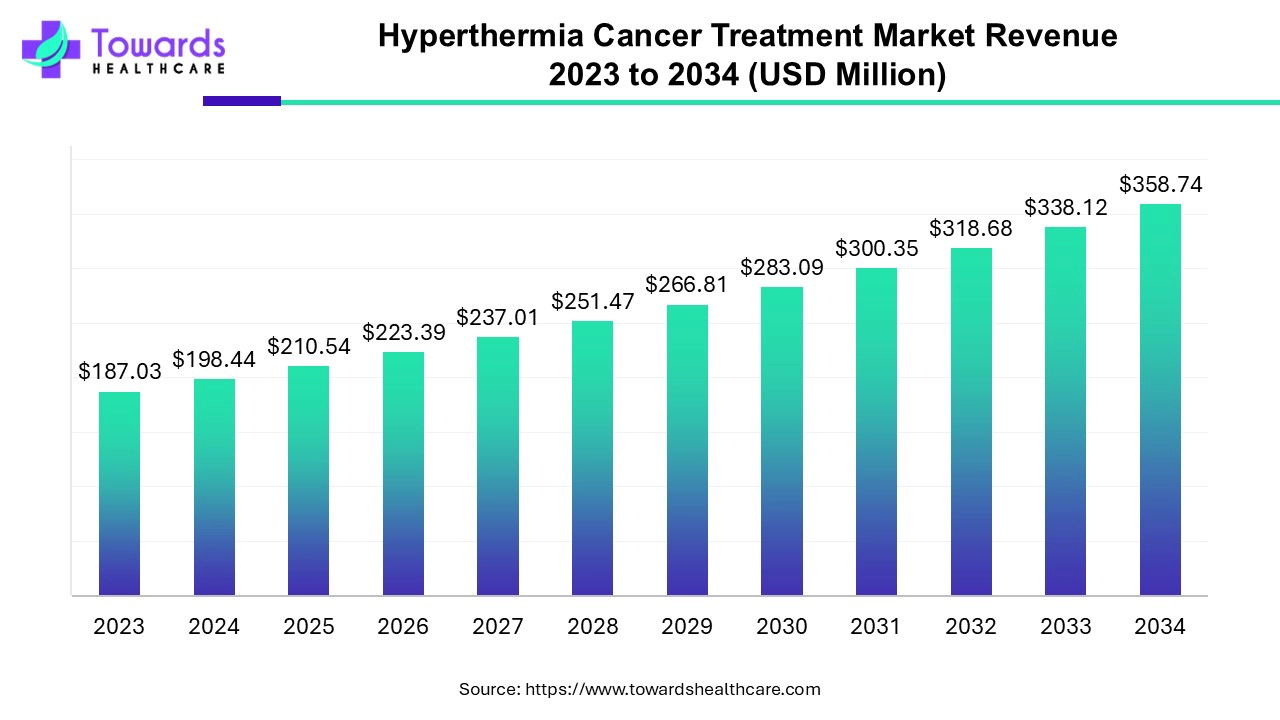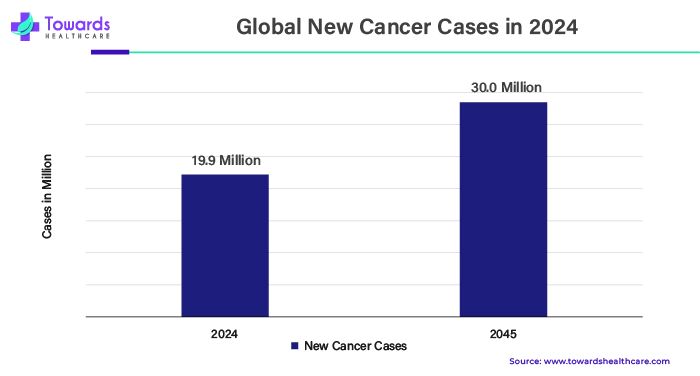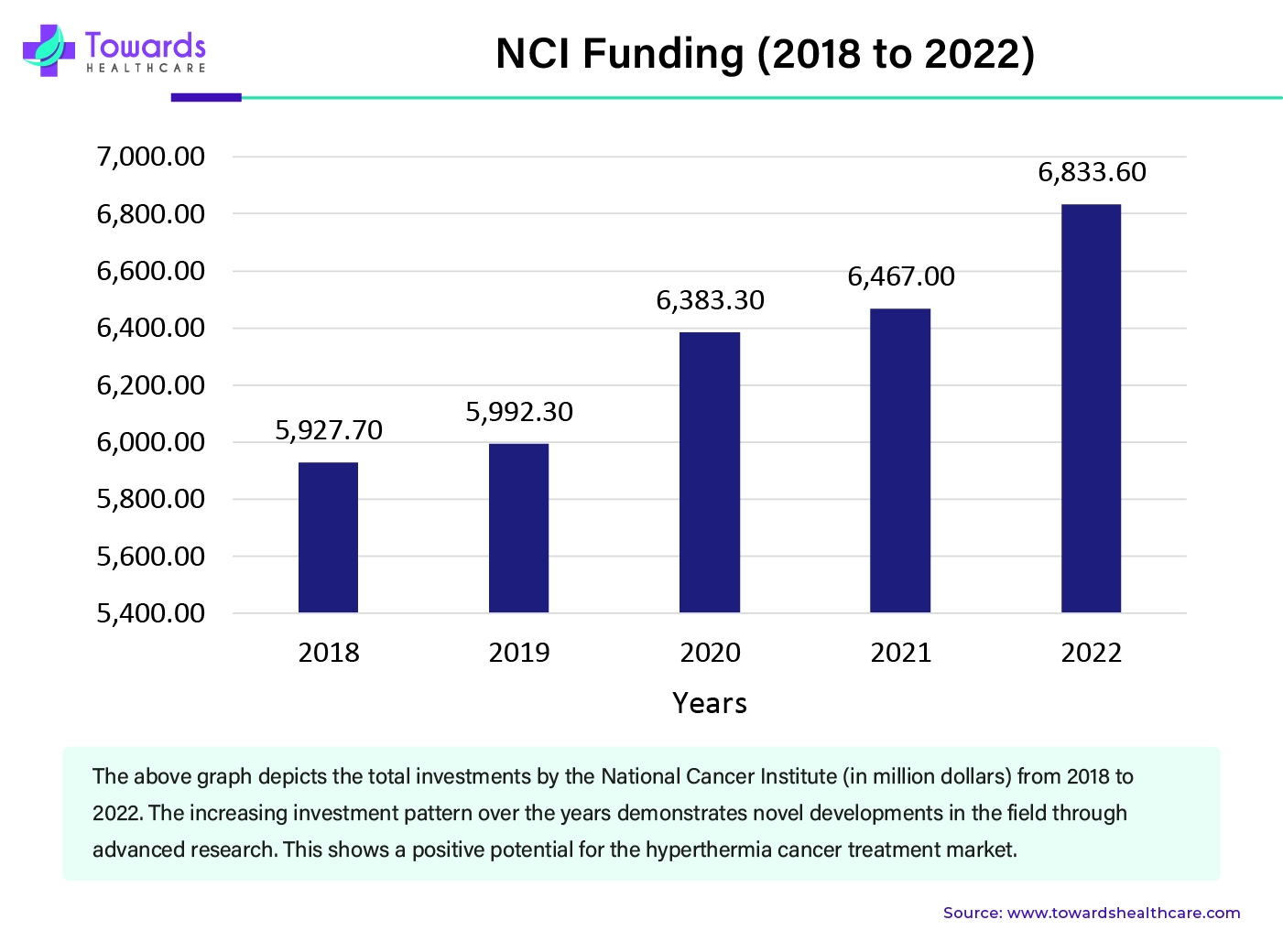April 2025

The hyperthermia cancer treatment market was estimated at US$ 187.03 million in 2023 and is projected to grow to US$ 358.74 million by 2034, rising at a compound annual growth rate (CAGR) of 6.1% from 2024 to 2034. The rising incidences of cancer, growing research & development, and increasing investments drive the market.

Hyperthermia is a novel approach to treat different types of cancer, along with radiation therapy and chemotherapy. Hyperthermia involves heating the body temperature around 111 to 113oF. This temperature enables the destruction of the cancer cells within the body while posing no or minimal harm to the normal cells. This approach can also make other cancer treatments more effective. There are usually three types of hyperthermia treatment: local, regional, and whole-body. In local hyperthermia treatment, a specific small tumor area of the body is provided with heat using radiowaves, electromagnetic waves, or ultrasound waves. In regional hyperthermia treatment, larger body areas such as body cavities, organs, or limbs are provided with heat.
Meanwhile, in whole-body hyperthermia treatment, the entire body is heated up when the tumor is spread throughout the body. Hyperthermia has shown promising results in many patients; however, many therapies are being tested in clinical trials. Studies are also ongoing about the long-term effects of these treatments on cancer patients.
The integration of artificial intelligence (AI) in the healthcare sector has shown immense potential in improving the health and well-being of patients. AI and machine learning tools help resolve information processing problems, including pattern identification, classification, clustering, natural language processing, and predictive analysis. AI-based algorithms can be useful in hyperthermia treatment by proposing the type of hyperthermia treatment to be used in the patients depending on the type and severity of the disease. AI can also detect the precise temperature of the tumor cells undergoing treatment. Chemotherapy is also administered along with the hyperthermia technique. Several researchers have investigated the role of AI in obtaining data on drug release patterns, resistance prediction, dosing optimization, combination of drug selection, pharmacokinetic profile characterization, and outcome prediction to heat generation estimation.
| Company Name | Sona Nanotech, Inc. |
| Headquarters | Nova Scotia, Canada |
| Recent Development | In September 2024, Sona Nanotech, Inc. announced the raise of $1.643 million in gross proceeds to advance its novel cancer therapy and general corporate purposes. The company’s innovative Targeted Hyperthermia Therapy is expected to undergo a first-in-human clinical trial. |
| Company Name | Zhongshan Hospital |
| Headquarters | Xuhui District, Shanghai, China |
| Recent Development | In August 2024, the affiliated Zhongshan Hospital of Dalian University launched a comprehensive Hyperthermia Center within its expansive 22-acre campus. The center plans to incorporate 20 hyperthermia devices by Parexel Medical by the end of 2024. |
The increasing incidence and prevalence of different types of cancer is a major reason for potentiating the hyperthermia cancer treatment market. According to the WHO, approximately 20 million new cancer cases globally were reported in 2022 and are estimated to reach 35 million by 2050. Hence, this potentiates the development of novel therapeutic strategies in addition to radiation and chemotherapy. Hyperthermia is one such technique, which can show synergistic effects with radiation and chemotherapy.
Hyperthermia has shown promising results in destroying cancer cells and shrinking tumors. It can also be used in patients who aren’t healthy enough to have surgery or for tumors that are too hard to reach for surgery. This technique is also being evaluated to reduce the recurrence rates of cancer. The recurrence depends on the type and stage of cancer. Additionally, the increasing investments in cancer research boost the market. According to a 2021 study, the International Cancer Research Partnership demonstrated an increase in research funding from US $5.5 billion in 2006 to US $8.5 billion in 2018. Of these, 44% of funders were from the USA, 21% from Europe, and 16% from Asia.

The major challenge for the market is the high cost of the hyperthermia device. The price of this device depends on its size. The average cost of smaller machines for outpatient settings is usually around $40,000 to $100,000, whereas that of larger machines for hospitals and clinics is around $500,000. Also, the average treatment cost of hyperthermia ranges from $20,000 to $50,000. This limits its widespread use across all nations globally. Additionally, there is a lack of insurance policies that cover hyperthermia treatment. Another major challenge for this market is the lack of sufficient data related to hyperthermia treatment and patient outcomes. This technique is still at an experimental stage, and more research is needed to understand hyperthermia’s role in cancer treatment. This also results in a lack of skilled professionals.
Nanomaterials or nanoparticles (NPs) are one of the most emerging fields in research due to their extraordinary properties. Several nanoformulations are available in sizes ranging from 1 to 100 nm, incorporating anti-cancer drugs. They possess excellent drug delivery capability to transport a drug to the target with reduced side effects and high levels in the tumor region. Magnetic NPs have gained significant importance due to their unique superparamagnetic properties, i.e., these NPs are magnetized in the presence of alternating external magnetic fields (AMF).
Hence, they easily release the drug in the tumor region with the help of a magnetic field. Also, these NPs can generate high temperatures in the presence of AMF. Hence, this strategy can enhance treatment efficacy by enhancing drug release within and near the tumor region, thereby reducing side effects. At present, there are three USFDA-approved magnetic nanoparticles that are used for other purposes. However, numerous research are ongoing on the development of magnetic nanoparticles and to study their effects on humans.
The microwave hyperthermia device segment held a dominant presence in the hyperthermia cancer treatment market in 2023. Microwave hyperthermia devices are considered to be safe and efficient for the treatment of cancer. In this technique, electromagnetic waves are used, which mainly focus energy on the tumor to elevate its temperature while posing minimal injury to the surrounding normal tissues. Hence, microwave hyperthermia applicator design is important for the effectiveness of the therapy and the feasibility of real-time application. Additionally, microwave hyperthermia equipment offers a range of heating techniques to treat a variety of tumors regardless of the size and depth.
The breast cancer segment accounted for the dominant share of the hyperthermia cancer treatment market in 2023. The rising incidences of breast cancer drive the market. Breast cancer is the most frequent cancer type in women all over the world, accounting for around 30% of the cancer malignancies. According to the World Cancer Research Fund International, there were approximately 2.2 million new breast cancer cases globally. Conventional chemotherapeutic drugs have adverse effects by targeting not only tumor cells but also healthy cells. This damages the healthy cells of the breast. Hence, hyperthermia treatment is preferred to increase the effectiveness of the chemotherapy and reduce the adverse effects. Hyperthermia increases the temperature of the targeted region and attracts temperature-sensitive drugs, promoting the effectiveness of the drugs in the tumor area instead of healthy cells.
The hospitals segment registered its dominance over the global hyperthermia cancer treatment market in 2023. Hyperthermia treatment is majorly used in hospitals for treating cancer patients. Hospitals provide favorable infrastructure for the installation of hyperthermia devices. They also have access to trained and experienced healthcare professionals like physicians, anesthetists, oncologists, surgeons, etc., for the patients. Additionally, to execute hyperthermia treatment, imaging devices such as MRI and CT scans are required to assess the probe of the hyperthermia device within the body. Hospitals possess both the infrastructure and the trained personnel for the same. Moreover, the availability of abundant capital investments in the hospitals favors the use of such techniques. The number of cancer patients visiting hospitals is higher, promoting hyperthermia treatment.
North America held the largest share of the hyperthermia cancer treatment market in 2023. The rising incidences of cancer, state-of-the-art healthcare infrastructure, and advanced research and development facilities drive the market growth. There are more than 1,100 hospitals and 72 NCI-designated cancer centers in the US. The market is also driven by the increasing government and private investments in cancer research in the region. The country with the highest investment globally in cancer research is the US. The National Cancer Institute (NCI) is at the forefront of funding research projects and clinical trials related to any type of cancer. Approximately 1.9 million and 0.23 million new cancer cases were reported in 2022 in the US and Canada, respectively. Additionally, the presence of skilled professionals and favorable infrastructure augments the market growth.

Asia-Pacific is projected to host the fastest-growing hyperthermia cancer treatment market in the coming years. The increasing population, rising incidences of cancer, growing research & development, and increasing investments & collaboration drive the market. China reported the highest number of cancer patients globally in 2022, with around 4.8 million new cancer cases. At the same time, India reported 1.4 million new cancer cases in 2022. The favorable government policies to promote hyperthermia research boost the market. The scientists from the Institute of Nano Science and Technology (INST), Mohali, recently demonstrated the effectiveness of a magnetic hyperthermia-based cancer therapy approach to reduce chemotherapy doses. Additionally, expanding healthcare infrastructure and increasing awareness about hyperthermia treatment augment the market growth.
For instance,
By Device Type
By Application
By End-User
By Region
April 2025
April 2025
March 2025
March 2025